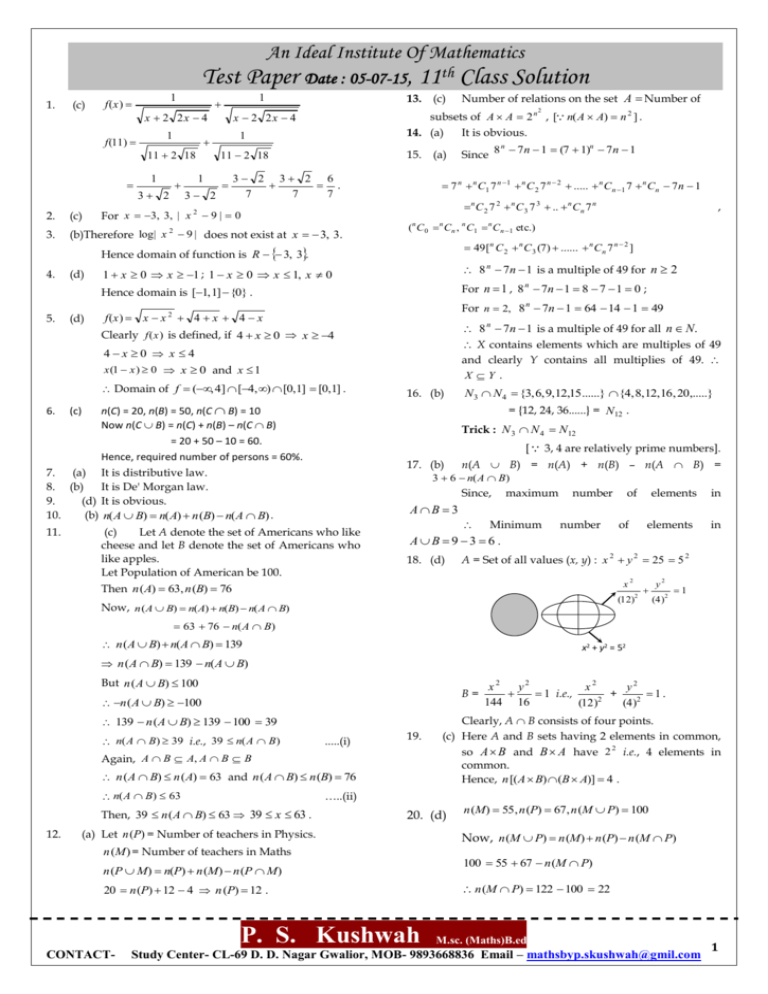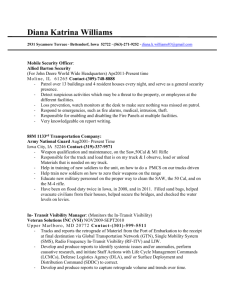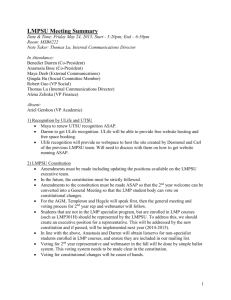Hence domain is - Abhilasha Classes
advertisement

An Ideal Institute Of Mathematics
Test Paper Date : 05-07-15, 11th Class Solution
1.
(c)
1
f (x )
x 2 2x 4
1
f (11)
1
3 2
2
1
11 2 18
1
3 2
15. (a)
3 2 3 2 6
.
7
7
7
(c)
3.
(b)Therefore log| x 2 9 | does not exist at x 3, 3.
(d)
7 n n C1 7 n 1 n C 2 7 n 2 ..... n Cn 1 7 n Cn 7 n 1
(d)
n
1 x 0 x 1 ; 1 x 0 x 1, x 0
8 n 7n 1 is a multiple of 49 for n 2
For n 1 , 8 n 7n 1 8 7 1 0 ;
For n 2, 8 n 7n 1 64 14 1 49
f (x ) x x 2 4 x 4 x
Domain of f (, 4] [4, ) [0,1] [0,1] .
n(C) = 20, n(B) = 50, n(C B) = 10
Now n(C B) = n(C) + n(B) – n(C B)
= 20 + 50 – 10 = 60.
Hence, required number of persons = 60%.
8 n 7n 1 is a multiple of 49 for all n N.
X contains elements which are multiples of 49
and clearly Y contains all multiplies of 49.
X Y .
16. (b)
N 3 N 4 {3, 6, 9,12,15 ......} {4, 8,12,16, 20,.....}
= {12, 24, 36......} = N12 .
Trick : N 3 N 4 N 12
[ 3, 4 are relatively prime numbers].
17. (b)
n(A B) = n(A) + n(B) – n(A B) =
3 6 n( A B)
Since, maximum number of elements in
7. (a) It is distributive law.
8. (b)
It is De' Morgan law.
9.
(d) It is obvious.
10.
(b) n( A B) n( A) n (B) n( A B) .
11.
n
49 [n C 2 n C 3 (7) ...... n Cn 7 n 2 ]
4x 0 x 4
x (1 x ) 0 x 0 and x 1
(c)
n
Hence domain of function is R 3, 3.
Clearly f (x ) is defined, if 4 x 0 x 4
6.
,
( C 0 C n , C1 C n 1 etc.)
n
Hence domain is [1, 1] {0} .
5.
n
n
Since 8 7 n 1 (7 1) 7n 1
n C 2 7 2 n C 3 7 3 .. n Cn 7 n
For x 3, 3, | x 2 9 | 0
2.
4.
Number of relations on the set A Number of
subsets of A A 2 n , [ n( A A) n 2 ] .
14. (a)
It is obvious.
x 2 2x 4
11 2 18
13. (c)
1
AB 3
(c)
Let A denote the set of Americans who like
cheese and let B denote the set of Americans who
like apples.
Let Population of American be 100.
Minimum
AB 9 3 6 .
18. (d)
number
of
elements
in
A = Set of all values (x, y) : x 2 y 2 25 5 2
x
Then n ( A) 63, n (B) 76
2
(12)
Now, n ( A B) n(A) n(B) n(A B)
2
y
2
(4 )
2
1
63 76 n( A B)
n ( A B) n( A B) 139
x2 + y2 = 52
n ( A B) 139 n( A B)
But n ( A B) 100
B=
n ( A B) 100
139 n (A B) 139 100 39
n( A B) 39 i.e., 39 n( A B)
.....(i)
19.
Again, A B A, A B B
n ( A B) n ( A) 63 and n ( A B) n (B) 76
n( A B) 63
12.
20. (d)
(a) Let n (P) = Number of teachers in Physics.
n (M ) = Number of teachers in Maths
n (P M) n(P) n (M) n (P M)
20 n (P) 12 4 n (P) 12 .
P. S. Kushwah
CONTACT-
Clearly, A B consists of four points.
(c) Here A and B sets having 2 elements in common,
so A B and B A have 2 2 i.e., 4 elements in
common.
Hence, n [(A B) (B A)] 4 .
…..(ii)
Then, 39 n ( A B) 63 39 x 63 .
x2
y2
x2
y2
1 i.e.,
+
1.
2
144 16
(4 )2
(12 )
n (M) 55, n (P) 67, n (M P) 100
Now, n (M P) n (M) n (P) n (M P)
100 55 67 n (M P)
n (M P) 122 100 22
M.sc. (Maths)B.ed
Study Center- CL-69 D. D. Nagar Gwalior, MOB- 9893668836 Email – mathsbyp.skushwah@gmil.com
1
Now
21.
n
(P
only)
=
n (P) n(M P)
For n 2, 8 n 7n 1 64 14 1 49
67 22 45 .
8 n 7n 1 is a multiple of 49 for all n N.
(c) In general, A B B A
X contains elements which are multiples
A B B A is true, if A = B.
22.
(b) From De’ morgan’s law, ( A B) A B .
23.
(d)
of 49 and clearly Y contains all multiplies of
49. X Y .
n( A) 4 , n(B) 3
34. (b)
N 3 N 4 {3, 6, 9,12,15 ......} {4, 8,12,16, 20,.....}
n( A) n(B) n(C ) n( A B C )
4 3 n(C ) 24 n(C )
24.
= {12, 24, 36......} = N12 .
24
2.
12
Trick : N 3 N 4 N12
[ 3, 4 are relatively prime numbers].
(c) Given set is {(a, b) : 2a 2 3b 2 35 , a, b Z}
35. (b)
We can see that, 2(2)2 3(3)2 35
3 6 n( A B)
and 2(4 ) 3(1) 35
2
n(A B) = n(A) + n(B) – n(A B) =
2
Since, maximum number of elements in
(2, 3), (2, –3), (–2, –3), (–2, 3), (4, 1), (4, –1),
AB 3
(–4, –1), (–4, 1) are 8 elements of the set.
Minimum
number
of
elements
n 8.
AB 9 3 6 .
25. (a)
It is distributive law.
36. (b)
26. (b)
It is De' Morgan law.
37. (a)
27. (c)
(A – B) (B – A) = (A B) – (A B).
28. (c)
n( A B) pq .
29. (c)
B C = {c, d} (d, e} = {c, d, e}
38. (b) Solution: We have, 4 - x < 2 – 3
⇒
3x – 9 – 12x < 6x – 6 – 4x + 8
⇒
- 11x < 11
⇒
-x<1
⇒
x>-1
…… (i)
and
2 – x > 2x – 8
10
⇒
- 3x > - 10
⇒
x<
3
……. (ii)
From Eqs. (i) and (ii), the solution of the
given system of inequalities is given by x ∈
10
(−1, 3 ).
Hence, (b) is the correct answer.
(x−1)(x−2)
39. (b) Solution:
≤0
(x−3)
x−3
A × (B C) = {a, b} × {c, d, e}
= {(a, c), (a, d), (a, e), (b, c), (b, d), (b,
e)}.
30. (a,b) R (P c Q c )c R [(P c )c (Q c )c ]
= R ( P Q ) ( R P ) (R Q ) = (R Q ) ( R P ) .
31. (d)
It is fundamental concept.
32. (b) It is fundamental concept.
33. (a)
x−1
in
x−2
Since 8 n 7n 1 (7 1)n 7n 1
7 n n C1 7 n 1 n C 2 7 n 2 ..... n Cn 1 7 n Cn 7 n 1
,
n C 2 7 2 n C 3 7 3 .. n Cn 7 n
(n C 0 n C n , n C1 n C n 1 etc.)
49 [n C 2 n C 3 (7) ...... n Cn 7 n 2 ]
8 n 7n 1 is a multiple of 49 for n 2
x ≤ 1 or 2 ≤ x < 3 ⇒ (- ∞, 1] ∪ [2, 3]
Here, interval is closed at 1 and 2 as numerator
becomes zero so inequality hold true but open
at 3 as (x – 3) is in the denominator, so x = 3
makes left hand side undefined.
Hence, (b) is the correct answer.
x−1
40. (d) Solution:
-2≥0
x
For n 1 , 8 7n 1 8 7 1 0 ;
n
P. S. Kushwah
CONTACT-
⇒
⇒
x−1−2x
≥
x
1+x
≤0
x
0⇒
− 1− x
≥
x
0
M.sc. (Maths)B.ed
Study Center- CL-69 D. D. Nagar Gwalior, MOB- 9893668836 Email – mathsbyp.skushwah@gmil.com
2
⇒ x ∈ [-1, 0)
Here, interval is closed at -1 as
numerator becomes zero so the
inequality holds true but open at 0 as
(x) is in the denominator, so x = 0
makes left hand side undefined.
Hence, (d) is the correct answer.
41. (a) Solution: Squaring both sides, we get
|x + 3|2 > |2x − 1|2
or {(x + 3) − (2x − 1)} {(x + 3) + (2x − 1)} > 0
{(−x + 4)(3x + 2)} > 0
⇒
2
⇒
x ∈ (− , 4)
3
Hence, (a) is the correct answer.
42. (c) Solution:Case – I When x 2 + 3x ≥ 0
⇒
x(x + 3) ≥ 0,
ie,
x ∈ (- ∞, - 3] ∪ [0, ∞) ….. (i)
In this case inequality becomes
x 2 + 3x + x 2 - 2 ≥ 0
or 2x 2 + 3x – 2 ≥ 0 or (x + 2) (2x – 1) ≥ 0
or
x ∈(- ∞, - 2] ∪ [ ½, ∞) ….. (ii)
From eqs. (i) and (ii) the solution in this
case is given by
1
x ∈ (-∞ , - 3) ∪ [2, ∞)
Case- II When x 2 + 3x < 0
ie,
x ∈ (-3, 0)
….. (i)
In this case, inequality becomes
- x 2 - 3x + x 2 - 2 ≥ 0
⇒
- 3x – 2 ≥ 0
2
⇒
x ≤ - 3 ….. (ii)
From eqs. (i) and (ii) the solution in this
case is given by
x ∈ (-3, – 2/3].
Combining the solutions of both cases, we have
x ∈ (-∞ , – 2/3] ∪ [1/ 2, ∞)
Hence, (c) is the correct answer.
43. (d)
44. (a)
45. (b)
46. (d)
47. (c)
48. (b)
49. (b)
50. (b)
P. S. Kushwah
CONTACT-
M.sc. (Maths)B.ed
Study Center- CL-69 D. D. Nagar Gwalior, MOB- 9893668836 Email – mathsbyp.skushwah@gmil.com
3











